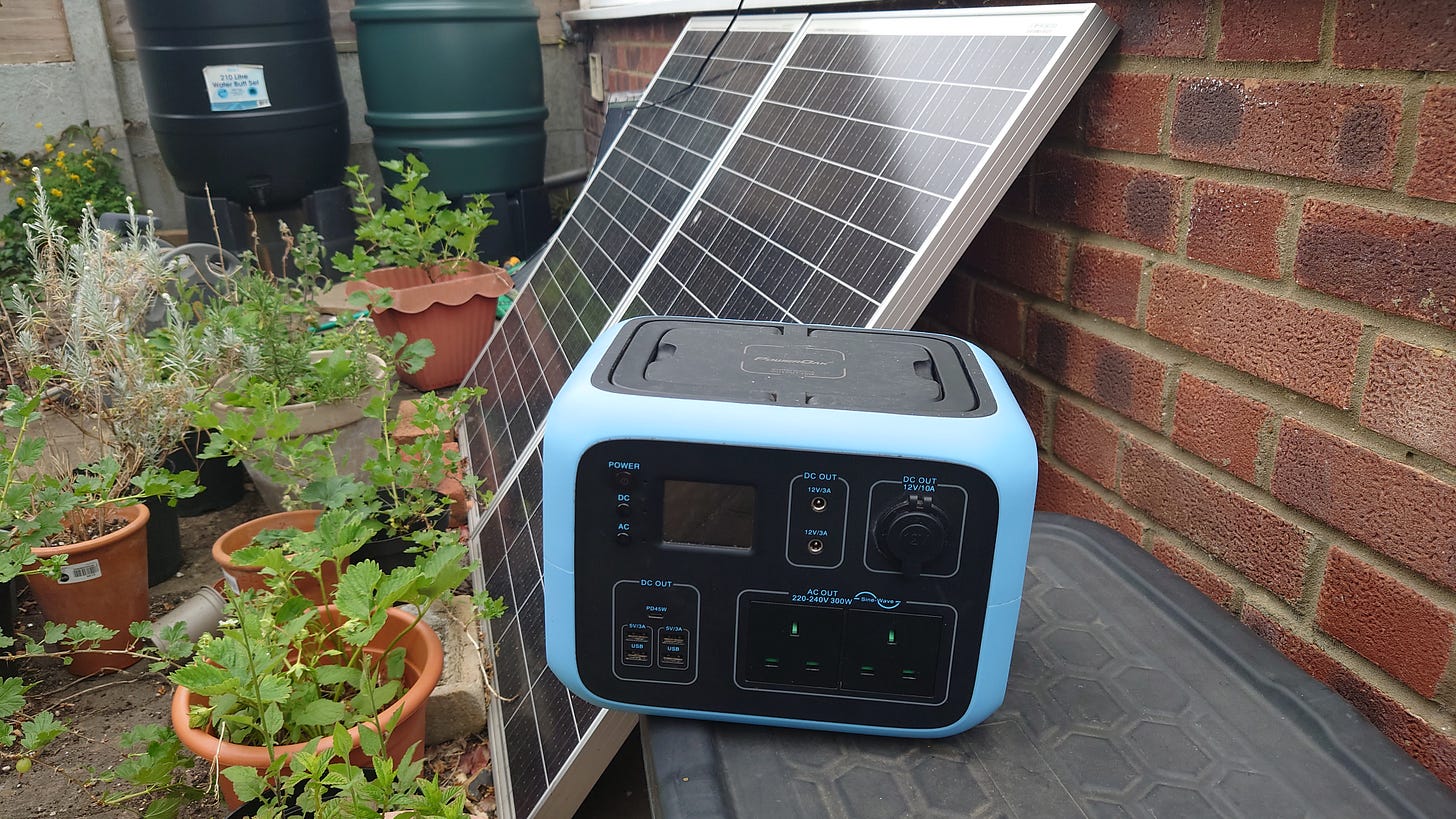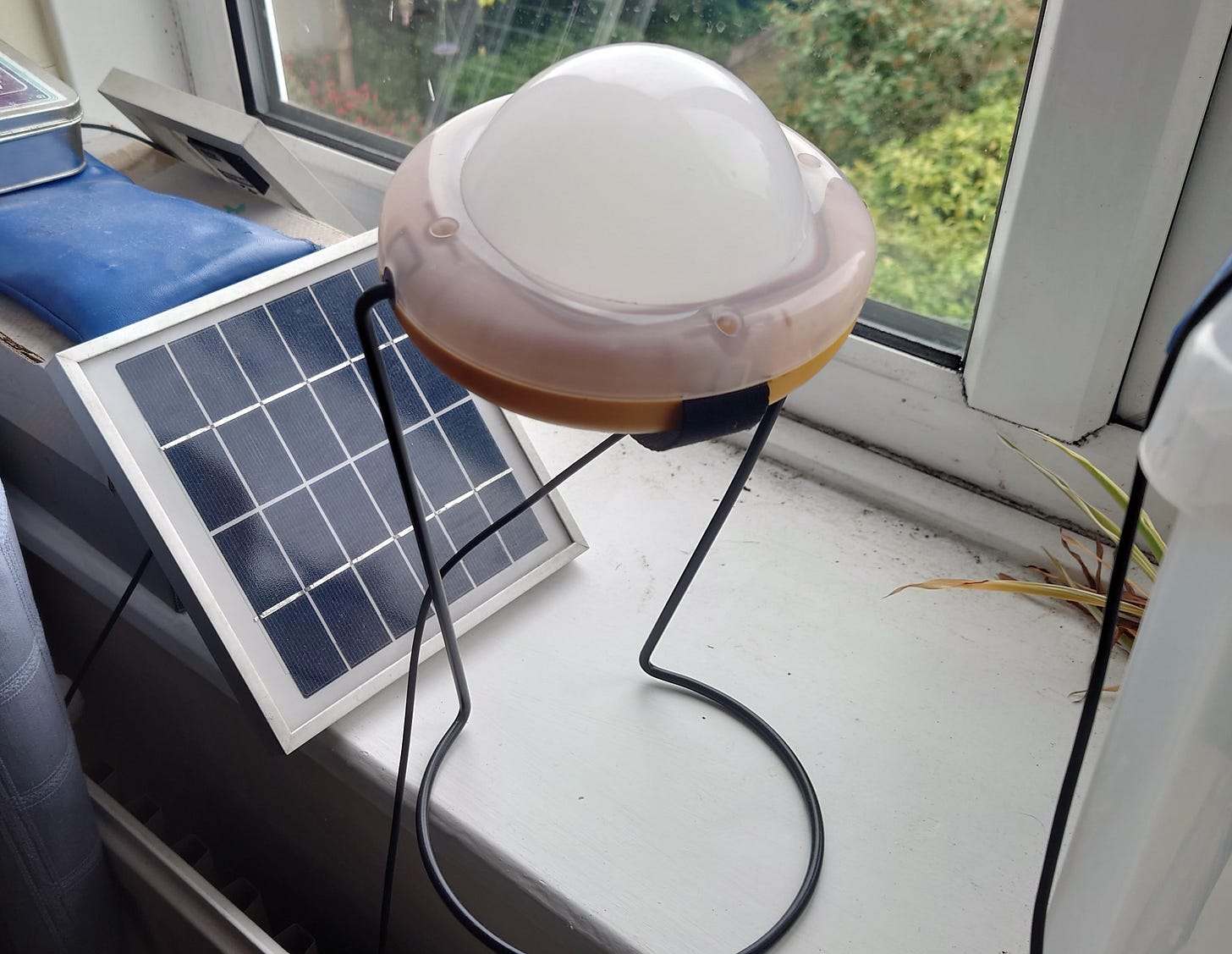Experimenting with portable Solar Power
How we set up a temporary solar power system in our rented house.
I believe that solar power has the potential to be transformative but it’s not easy to convert to it when you are renting. Unless you have a landlord willing to pay out to install solar panels on the roof then its really only possible to do small things to convert your power usage from mains electricity and gas to solar power.
In the UK, its also not possible to use solar all of the time. In the summer its possible to get a large propotion of power from the sun, but in the depths of winter there’s just not enough sunlight around. Mixing solar into the equation on a small sccale, at least reduces the need for fossil fuels.
At our home, we’re continually looking for ways to reduce our consumption but also to convert to alternative power supplies. To do that we’ve looked at the world of off-grid installations for inspiration and for those living in vans or tiny homes. In these instances uses of solar panels with solar generators work wonders. Nonetheless, these solutions can currently only provide a small amount of our power needs unless we find a way to upscale!
In today’s Side Stepping Normal essay, I explain our current setup and experimentation with solar power, as I’ve realised that I’ve never talked about this side of our attempts to break normality before!
Understanding Solar Power
For a long time I had been trying to get my head around how solar panels and electricity works. I still don’t fully understand it - I guess my brain just isn’t wired to understand the intricacies (or even the basics) of AC and DC! That’s okay though. What I released in the end was that I needed to experiment (in a safe way!).
What I mean by that is that about three years ago we brought a solar-powered generator and two hefty solar panels. As we rent our house we couldn’t simply put these panels on the roof so they sit in the back garden resting against the outside wall of the house, trying to capture what sunlight they can. The solar generator isn’t all that powerful. We brought a PowerOak 300w output with maximum of 240v capability. It’ good enough to charge phones and laptops but not much more than that.
These purchases have allowed us to understand some basics about connecting solar power to a battery and its served us well for several summers now. During Autumn and Winter, it will charge a bit, but when it gets to the darkest of the season we have to resort to topping it up by plugging it into the mains (to ensure the battery keeps working).
We’ve just come out of that dark period and we’ve been enjoying getting more free power from the sun, until a few days ago when the portable generator suddenly drained all of its power and refused to recharge. We tried plugging it back into the mains but still nothing. The thing was deader than a dodo! It seemed to recover though and is again working fine (perhaps it got too cold?). This, though, was a lesson on dependancy and the need for backups. To make this system work we really should have at least two generators working side by side and a plan to finance replacements when they do eventually degrade.
Charging with the Sun!
The solar panels and generator proved easy to setup. We placed the two solar panels in parallel so that they both charge the same connection; which plugs into our generator. The generator itself goes into a black plastic container next to the solar panels, so that we can connect it to charge. This protects the generator from the weather, but it’s not entirely ideal. It gets too hot in there (or too cold, sometimes?), but at present there is nowhere else to place it.
When the system is working well, we get free power to charge laptops, phones, and other small electrical items. The generator can power from ordinary plugs (UK style) but also from USB an USB-C. Because its portable (with useful handles) it not only provides us with free power but avoids the need to streach cables from power sockets in the house and even lets us power things if we’re in the garden.
In our current circumstances this is about as good as we can get. We have also tried to charge solar lights from the solar panels. This hasn’t worked as well. The lights on the market are generally flimsy or have a light that’s too bright or dull. The ultimate aim, though, would be to avoid having to turn lights on in the house at all, and to essentially replace them with solar powered portable lights. This then, is a work in progess!
Sun King Solar Lights
Before we began these experiments we tried something much similar with lighting. This was years ago. At that time there was a company called Sun King which sold robust solar lamps with a simple stand and a mini solar panel. These are fantastic! They were designed for use in countries across Asia and Africa, such as Cameroon, Kenya, and Nigeria, to provide affordable light for free. The company still exists but don’t seem to sell their products in the UK any more.
From our point of view this is a shame, but it’s also understandable. Sun King’s mission is to:
“develop products for households and businesses who cannot access, rely on or afford traditional electic grid connections.”
This is a good aim and knowing what these lamps are like I know that they can make a difference. They are robust, easily movable, and offer a good light which lasts a long time without the need for a further charge. It’s also possible to charge a mobile phone from them (which we have done occasionally at the height of summer).
I don’t know why this is the case, but in the UK at least there are very few options for robust lamps that are solar powered. Most solar powererd lighting is designed for gardens and much of that breaks extremely quickly. The other alternative are small lights designed for camping, which work well but generally provide a light that’s not very nice inside a house. I’ve never seen a product on the market that matches the quality or purpose of Solar King, which is a shame.
Before Sun King moved away from the UK market, we brought five of their lamps with mini solar-panels, and for years now, these lamps have replaced our bedside lamps and are often carried with us at night if we need to go to the toilet. If we want a duller light in the evening these work great as well.
The future
Our solar setup helps with replacing mains power for lighting. The Sun King lamps work great as lamps but are not so useful as a replacement for the main light in a living room or kitchen. We’ve experimented with other portable lights (often camping lights) instead. This almost works but the quality of the light doesn’t quite seem to work or the light is not all that robust and breaks quickly. Our hunt continues for the perfect light which can be charged using solar power.
The solar generator is really useful, but it’s far too underpowered to do anything more than charge laptops and phones. In the future we hope to upgrade and buy at least two higher watt versions which can be charged during the day and then used to power items like kettles or toasters. However, the cost of solar generators is somewhat prohibitive. Most higher watt models cost towards £1000 which is quite an outlay!
The idea of using portable solar solutions within a rented house can work, but it takes some creative thinking and changes to how you use power. Ideally, I’d charge my laptop in the evening or early morning, then put the generator out through the day. However, I work all day with my laptop so it has to have additional charges through the day.
Ideally, we’d find a light that works as a replacement for the lights in the living room and kitchen (at the very least). These can be portable solar-charged lights which we simply hook on the ceiling.
All of this is a work in progess, but I do believe it is possible to replace a fair amount of electrical power with solar - at least for part of the year, even in a rented house.
This article is free for all readers. If you would like to support our work with a one-off contribution, click the “Buy me a Coffee” button below.
If you would like to support Side Stepping Normal with a monthly or annual subscription, and receive more of our writing about finding a good life in a time of climate change and ecological decline, click the “Subscribe now” button below for options.



